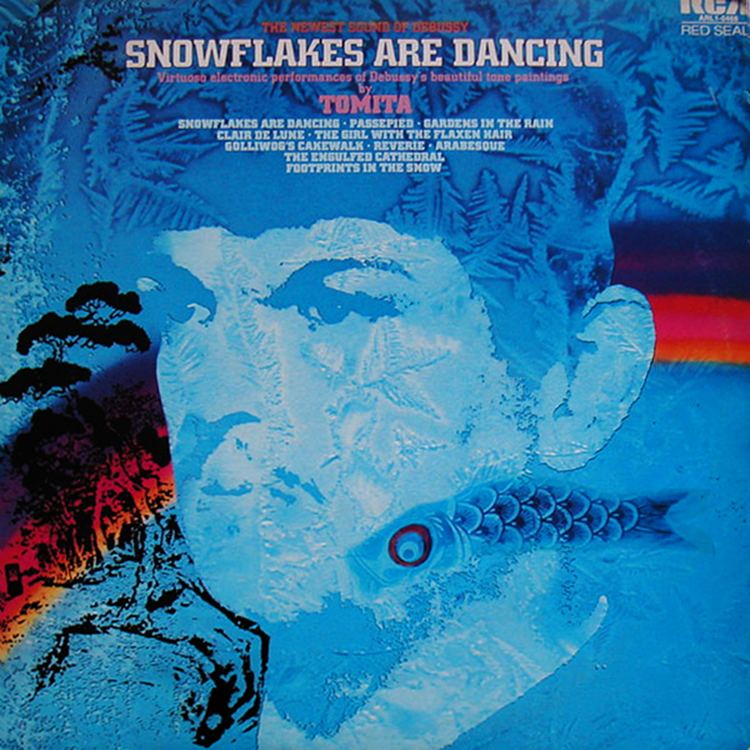Released April 12, 1974 Producer Plasma Music Release date 12 April 1974 | Recorded 1973-4 Label RCA Red Seal Records | |
 | ||
Length 41:33 (51:51 in the 2000 CD release) Switched On Rock(1972) Snowflakes Are Dancing(1974) Snowflakes Are Dancing(1974) Pictures at an Exhibition(1975) Similar Isao Tomita albums, Classical music albums | ||
Snowflakes Are Dancing is the second studio album by Japanese musician Isao Tomita, recorded in 1973-4 and first released as a Quadradisc in April 1974. The album consists entirely of Tomita's arrangements of Claude Debussy's "tone paintings", performed by Tomita on a Moog synthesizer. It entered the top 50 charts in the United States, where it was nominated for four Grammy Awards in 1975, including best classical album of the year, and it was NARM's best-selling classical album of the year.
Contents
- Debussy snowflakes are dancing side 1
- Overview
- Side A
- Side B
- Bonus track 2000 CD release
- Recording
- Songs
- References
Debussy snowflakes are dancing side 1
Overview
The use of the term tone paintings here describes the nature of a large portion of Debussy's work which was concerned with mood and colour, eschewing traditional tonality in favour of constructions such as the full-tonal scale, parallel chords, bitonality, and to a certain extent atonality, in order to achieve a greater degree of musical expression not allowed by strict adherence to a single key. Thus, the term tone painting is quite appropriate, in that Debussy's compositions often experimented with a much broader palette of tones, allowing each to behave similar to a colour within an illustration.
The album is considered an early example of proto-synthesizer-pop. It sparked a "revolution in synthesizer programming" which it was responsible for taking to new heights. The album's contributions to electronic music included an ambience resembling a symphony orchestra, the use of reverberation, the use of phasing and flanging to create a spatial audio effect with stereo speakers, electronic surround sound using four speakers, realistic string simulations, portamento whistles, and abstract bell-like sounds created using ring modulation. A particularly significant achievement was its polyphonic sound, which was created without the use of any polyphonic synthesizers (which were not yet commercially released). Tomita created the album's polyphonic sounds by recording selections one part at a time, taking 14 months to produce the album. The modular human whistle sounds used would also be copied in the presets of later electronic instruments.
The track "Arabesque No. 1" was used from 1976 to 2011 as the theme music for the PBS astronomy-based program Jack Horkheimer: Star Hustler (later Jack Horkheimer: Star Gazer); however, its use as the theme was discontinued when the show was revamped as Star Gazers. In Japan during the late 70s, parts of the track "Reverie" were used for the opening and closing of Fuji TV's transmissions.
Side A
- "Snowflakes Are Dancing" – 2:10
- "Reverie" – 4:44
- "Gardens in the Rain" – 3:41
- "Clair de lune" – 5:48
- "Arabesque No. 1" – 3:57
Side B
- "The Engulfed Cathedral" – 6:18
- "Passepied" – 3:17
- "The Girl with the Flaxen Hair" – 3:25
- "Golliwog's Cakewalk" – 2:50
- "Footprints in the Snow" – 4:30
Bonus track (2000 CD release)
11. "Prelude to the Afternoon of a Faun" – 10:18 (from the 1975 album Firebird)The title track appears to be a mistranslation back into English of an other-language (probably Japanese) version of Debussy's original title, The Snow Is Dancing (Debussy used English titles for most of pieces in his Children's Corner suite).
Recording
The album sleeve names the recording hardware used by Tomita to create the work.
Songs
1「子供の領分」第4曲〜雪は踊っている2:15
2夢4:48
3Gardens in the Rain (Estampes - no 3)3:44
